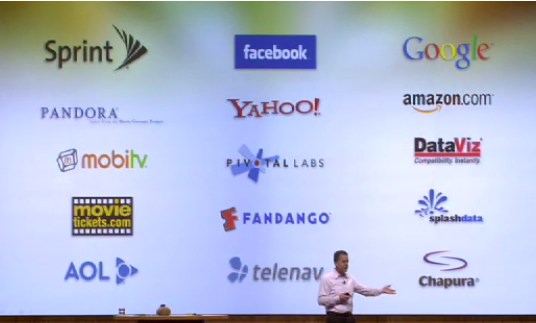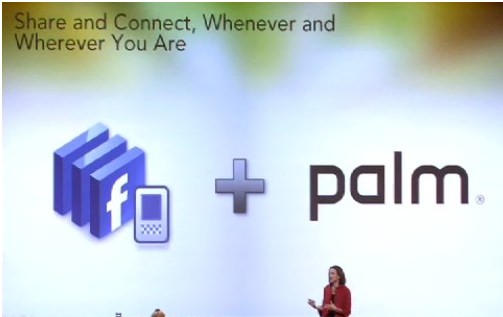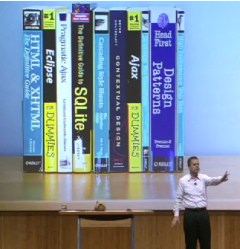Partners in Precrime, Part 1
 One of the most interesting – and most quickly glossed-over - parts of Palm's CES presentation was Ed Colligan's announcement of multiple third-party software partners on the new webOS. As any regular Palm user can tell you, it's third-party applications that truly seal the deal for smartphones and whilst a robust first-party software package is essential, third-party apps can make the difference between a platform earning your lifelong loyalty or being abandoned for a younger, sexier rival. With this in mind and in the absence of fresh news from Palm, it's time to take a closer look at these partners and how they might integrate with the webOS. So put on your Educated Guesswork caps and fire up the Speculation Engines as we take a closer look at Palm's partners in crime...
One of the most interesting – and most quickly glossed-over - parts of Palm's CES presentation was Ed Colligan's announcement of multiple third-party software partners on the new webOS. As any regular Palm user can tell you, it's third-party applications that truly seal the deal for smartphones and whilst a robust first-party software package is essential, third-party apps can make the difference between a platform earning your lifelong loyalty or being abandoned for a younger, sexier rival. With this in mind and in the absence of fresh news from Palm, it's time to take a closer look at these partners and how they might integrate with the webOS. So put on your Educated Guesswork caps and fire up the Speculation Engines as we take a closer look at Palm's partners in crime...

webOS's rap sheet
webOS 101
To prepare the ground, let's first recap what we know of Palm's new OS:
- Applications will be built using well-known web technologies: HTML5, CSS and Javascript. Although webOS is Linux-based, "native" development in C will not be an option – at least at first. Palm have created all their own in-built applications with these languages. As Ed Colligan put it: "We're eating our own dog food here."
- Applications will be able to run in the background – enabling "true" multitasking as we see on Windows Mobile, rather than the more limited multitasking available on PalmOS (which doesn't really multitask at all) and iPhone (which does not allow third-party apps to run in the background).
- Applications will have open access to your PIM data – so contacts, calendar, email and messaging are all fair game. webOS's "Synergy" concept means it will be able to integrate data from multiple web services into one view.
- Applications will have access to the innovative pop-up notification area, giving you some limited control over what they're up to at all times, no matter what else you're working on.
So, are you pumped? Primed? Onwards!
Sprint
Who are they? Named as the first (and limited-time exclusive) US carrier of the Palm Pre, Sprint needs no introduction. Much like Palm, the beleaguered US phone network has been shedding subscribers of late as it fights a pitched battle against popular perceptions of unreliability and mass customer dissatisfaction. One bright spot: the network came up trumps in Gizmodo's coast-to-coast 3G download speed test, although it was bested in upload rates by rival AT&T.
They've long been a reliable partner for Palm, having sold every CDMA smartphone ever offered by the company - both PalmOS and Windows Mobile - and lacking their own signature smartphone (like AT&T's iPhone or Verizon's Blackberry Storm) they were an obvious choice as Pre launch partner. CEO Dan Hesse certainly sees the value in having an "iconic device", as he recently told the San Francisco Chronicle:
"In today's market, iconic devices, no question, they move the needle, they grab attention. And we're very excited about the Palm Pre. I will give (BlackBerry manufacturer) Research In Motion credit for creating a great business phone and the iPhone, I give it credit for being a great consumer device. This is the first one I belive that really crosses both. It's an outstanding business device and it's also a whole life consumer device. It's a combination of a superb touch screen with a physical keypad, which is, for a heavy e-mailer and texter, a must. We think it's going to be a very successful device."
What's their contribution to webOS? Sprint recently announced a mobile Java platform named Titan, which combines a Java development environment with the OSGi Framework, which as described by Java developer David Beers is "a service platform that enables developers to create software by plugging together software components... widgets can interoperate with other components in the container: components for GPS location, messaging, multimedia, etc..." According to Beers, webOS's architecture bears "more than a passing resemblance to Titan".
In layman's terms, OSGi is a cross-platform technology which - should Palm choose to take to its logical conclusion - will mean developers could write Java-based webOS apps that will run with the performance of native apps, with a native look-and-feel, no matter which underlying OS is running the show, be it Linux, Windows or OS X. Which in turns means that when Palm announce their desktop plans for webOS devices – and it's more likely than not that a desktop component is in the pipeline – they're possibly going to include some kind of capability for webOS applications to also run on your desktop or laptop PC. Developers could target a range of different platforms with little effort. Could be a very compelling proposition and enable Palm to entice a lot of third-party talent.
What does all that have to do with Sprint and Titan? Well, Sprint already has their own base of mobile developers that they will surely be eager to convert to their shiny new toy, and if webOS is utilizing Java and OSGi then Titan developers shouldn't have too much trouble porting over applications they may have already developed for other Sprint handsets.
Who are they? Surely you've heard of Facebook. (Unless you've been hiding under a rock. On another planet. In an alternate universe.) The social network has seen runaway success since its 2004 inception and now attracts, globally, around 222 million monthly visitors. It features multiple methods of communicating with your "friends", from Walls, to picture sharing, to blogs via Notes, and allows you to leave comments on pretty much anything. They've been beefing up their mobile presence, with native applications now available for Palms, Blackberries and iPhones in addition to an ever-more-capable mobile web version. (We reviewed the native PalmOS app last year.)

How will it integrate with webOS? There's a lot of potential here. For starters, we know that it will be completely integrated with your contacts via Synergy: so, for instance, when your Facebook friends update their profile picture, so too will their contact picture on your phone without you having to lift a finger. Any contact information they have on their profile – phone numbers, email addresses and IM names – will also appear on your phone and be cached locally for offline access. In addition, any Events that your friends have listed on Facebook will also appear on your webOS calendar – as leaked screenshots from the Mojo SDK seem to imply.
Apart from the PIM aspect, the webOS Facebook application should also – in theory – allow you access to the full suite of custom Facebook apps that are available on the desktop site, as the web-based development environment should make it simple for anything featured on the desktop version to be available natively on webOS.
Finally, as webOS apps have access to the pop-up notification area, running Facebook in the background should allow new Facebook notifications to be instantly delivered to your phone, from status updates to Wall posts to photo and Note tagging.
Who are they? Perhaps the biggest and most popular provider of online services, Google have a massive range of web applications that could (and undoubtedly will) be ported to webOS. Apart from the world's most popular search engine, Google also offer Google Maps, Gmail, Google Calendar, Google Docs, Picasa (a photo sharing service)... the list goes on and on.
Oh, and they also own a little thing called YouTube. Perhaps you've heard of it.
How will they integrate with webOS? Oh my. How won't they? We already know that webOS's universal search feature will allow you to start hammering away on the keyboard and instantly begin a Google (or Google Maps) search with one touch. We know that it's going to integrate your Gmail contacts and Google Calendar with their webOS counterparts via Synergy.
 Apart from this, there's also the tantalising possibility of fully-featured offline versions of Gmail and Google Documents – the latter which should be welcome news to anyone who wants an alternative to Documents to Go. Gmail will be able to easily notify you of new messages via notifications, and you'll have access to your contacts from other web services via Synergy, thus putting it a step ahead of even the desktop version.
Apart from this, there's also the tantalising possibility of fully-featured offline versions of Gmail and Google Documents – the latter which should be welcome news to anyone who wants an alternative to Documents to Go. Gmail will be able to easily notify you of new messages via notifications, and you'll have access to your contacts from other web services via Synergy, thus putting it a step ahead of even the desktop version.
Google Maps will be able to access your location information via Pre's built-in GPS and may even be able to offer you pop-up turn-by-turn directions via the notification area, even if you're busily texting/web searching/music-playlist-shuffling as you walk. Should be great for late-night pub crawls in unfamiliar territory...
YouTube access still has a big question mark hanging over it; however, it's reasonable to assume there'll be some kind of custom webOS YouTube browser, given how popular the same has proved to be on the iPhone. Failing that, rumours abound that a fully-fledged Flash plugin is being developed for webOS and it seems credible, based on Pre's beefy hardware. Finally, we're still optimistic that video recording capability will eventually be included, and once it is a direct "upload to YouTube" option would be made available.
Pandora Internet Radio
Who are they? From their website: "At Pandora, we have a single mission: To play only music you'll love." Pandora is a streaming Internet music service, which allows you to fine-tune playlists based on artists you already know you like. You create your own "stations" with a seed artist or song, and Pandora will then throw similar songs out at you, identified by way of their Music Genome Project, the "most sophisticated taxonomy of musical information ever collected". You further fine-tune your stations by rating songs with either a thumbs-up or thumbs-down rating. They used to be globally accessible, but went U.S.-only a few years back (much to the bitter, bitter disappointment of this Australia-based writer). It's a fantastic way to introduce yourself to bands you might otherwise have never had the opportunity to hear.
How will they integrate with webOS? Like most of the other software partners, Pandora will greatly benefit from the pop-up notification area, which should allow you to easily give a thumbs-up or thumbs-down to particular tracks without having to jump back to the app proper. Same deal with playback controls. The biggest frustration for users of the otherwise-excellent iPhone version is that it can't run in the background, thanks to Apple's draconian software rules. The webOS edition should have no such limitations, given Palm's trumpeting of webOS's multitasking capabilities. Finally, just as the iPhone version gives you an option to buy tracks from iTunes, it's possible the webOS Pandora will provide links to buy from Amazon's music store, for which a custom webOS application was demoed at Palm's CES event.
If you're curious to hear what Pandora think of webOS and the new Pre, you can check out our interview with Pandora CTO Tom Conrad.
TO BE CONTINUED...
Join us on PIC next week, where we'll once again let the speculation run rampant regarding webOS partners Amazon, Yahoo!, mobiTV, Pivotal Labs and DataViz.
Article Comments
(11 comments)
The following comments are owned by whoever posted them. PalmInfocenter is not responsible for them in any way.
Please Login or register here to add your comments.
RE: As Ed Colligan put it: 'We're eating our own dog food here.'
There are several that are quite content coding in their den at home as they turned over hot office girls that worked as "personal assistants" and had no desire to lead a group to grow a company. You all know who you are.
On a big corporate level, they have a good shot at mostly taking some Blackberry customers. I don't see much of an iPhone issue here since they are more looking at corporate and enterprise sales in their focus. So how many are buying Palm stock now? It doubled right after the announcement.
RE: As Ed Colligan put it: 'We're eating our own dog food here.'
RE: As Ed Colligan put it: 'We're eating our own dog food here.'
RE: As Ed Colligan put it: 'We're eating our own dog food here.'
There were zero iPhone developers a couple of years ago PLUS Apple swearing they wouldn't allow 3rd pary apps. Look at them now. I'm sure none of them are complaining iPhones don't match existing mobile OS's
So far the Pre;
(a) has had a well executed / received launch (possibly Palm's best)
(b) is as slick as anything currently on the market
(c) seems to have some core developers in tow already
(d) WebOS does not look like a stretch for developers
(e) has the sentiment associated with a long standing mobile trademark (Palm)
Pretty good bet that the Pre will be well supported by developers. All looks good to me so far.
Anyway - Half the apps on my Treo are phone enhancing apps. Let's hope these sort of 3rd party apps aren't even needed on the Pre
RE: As Ed Colligan put it: 'We're eating our own dog food here.'
This is your (faulty) imagination. Apple never said such a thing. I said from the get-go there'd be a proper SDK.
And I say the same for the *Pre* too. And no, I don't mean CSS/HTML/Java. We'll get C+ or whatever too.
RE: As Ed Colligan put it: 'We're eating our own dog food here.'
Probably more like dodgy journalism if that was untrue. But my point is; doesn't 'change' come with the territory in the tech market?
RE: As Ed Colligan put it: 'We're eating our own dog food here.'
Just don't bring up the Commodore-64 or Amiga here or you'll get all the non-change nostalgiacs.
Oops.
Easy does it on the OSGi, stuff pardner!
I'd like to qualify several things that you're quoting me on or suggesting that I might have been suggesting.
But I think I'm too tired to bother.
I will say this, however. According to my calculations, webOS, if bombarded with particles of OSGi at around 550MeV in a Large Hadron Collider positioned a few hundred yards to the southwest of Palm headquarters *could* cause the residents of Cupertino to be inundated by a 30 foot wall of molten lava. Or at a minimum drop some seriously loose coconuts on unsuspecting heads. Either way, watch out Apple!
David Beers
Senior Wireless Developer
MapQuest
www.pikesoft.com/blog
RE: Easy does it on the OSGi, stuff pardner!
(As I understood it, from a to b to c...
a) Titan is a Java dev platform which employs OSGi
b) webOS may be running a Java application server (based on leaked SDK screenshots) and is also possibly using some OSGi stuff
c) and if that's true it's just a hop, skip and a jump to cross-platform Java apps -presuming Palm allows people to write natively for said hypothetical webOS Java app server )
Mangled enough?
Latest Comments
- I got one -Tuckermaclain
- RE: Don't we have this already? -Tuckermaclain
- RE: Palm brand will return in 2018, with devices built by TCL -richf
- RE: Palm brand will return in 2018, with devices built by TCL -dmitrygr
- Palm phone on HDblog -palmato
- Palm PVG100 -hgoldner
- RE: Like Deja Vu -PacManFoo
- Like Deja Vu -T_W



As Ed Colligan put it: 'We're eating our own dog food here.'
Once StyleTap is iphone capable I'm outta here. I'm wondering where the Faithful will then congregate? I imagine PIC will be all over the WebOS. Maybe we'll see a StyleTap forum.